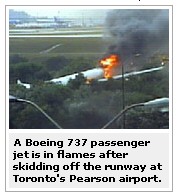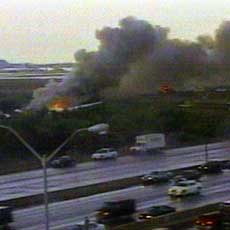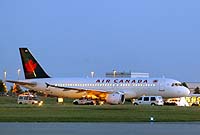|
|
|||||||
Passenger jet in flames at Toronto airportAir France - airbus 340 , flight 358 CTV.ca News Staff 8-2-05 A passenger jet burst into flames after skidding off the runway at Toronto's Pearson International Airport. There is no word on any casualties and the number of passengers was not immediately available. But Sgt. Glyn Griffiths confirmed reports that some of those on board had escaped the wreckage, saying an unspecified number of people have been taken to hospital and that some have been picked up after being found walking along the nearby highway. Griffiths indicated the aircraft was an Air France jet that was trying to land when it ran into trouble. "An Air France plane landing on runway 2-4 left went off the end of the runway the area of Convert Drive and the 401 area in Mississauga," said Griffiths. Griffiths couldn't say whether there were any injuries or if any passengers had been removed from the plane, but said there's been a full response by all emergency vehicles. Air France has not released a statement, but a ticket agent with the airline told Reuters that the burning plane is an A340 airbus that was travelling from Paris to Toronto. Live television pictures showed flames and smoke billowing from the aircraft in a wooded area just metres from Highway 401 -- Canada's busiest highway -- near the airport. A section of the plane's wing could be seen jutting from the trees. CTV Toronto's Jim Junkin reports that 200 people are thought to have been on board. Severe storms were hitting the area at the time of the accident. Eyewitnesses reported seeing lightning hit the plane before it burst into flames. The Greater Toronto Airport Authority is expected to hold a press conference sometime after 5 p.m. ET.
|
|||||||
|
|||||||
| AN ACCIDENT AVERTED JUST DAYS EARLIER | |||||||
"There was a problem that caused them to basically abort takeoff," airport spokeswoman Krista Kealey confirmed last night, noting that nobody was injured. "I really admire what the pilot did," said Simpson. "He was wonderful. He stopped it almost on a dime. It was expertly done. The guy (the pilot) deserves all the credit. "There was no B.S. He told us exactly what had happened and what was going to happen." SHREDDED TIRES Simpson said the plane's tires were shredded in the emergency stop and firefighters had fans under the aircraft to cool the overheated wheels and brakes. Air Canada spokeswoman Laura Cooke said the pilot noticed an engine indication light come on during takeoff. "As a precaution, he rejected takeoff and as a result the aircraft came to an abrupt stop on the runway which put, obviously, pressure on the brakes and tires," she said. Ottawa Fire platoon chief Dave Stevenson said they were called to assist airport fire crews with overheated brakes and tires but it turned out they weren't needed. "It had the potential to be worse than it was," he said. Simpson said they were told there was no danger of fire and everyone on board was "extremely calm." The cabin crew told them there was no need to evacuate. The flight originated in Halifax and stopped in Ottawa to pick up passengers and change the crew before continuing to Vancouver. Buses took the passengers to the terminal at about 9 p.m. Simpson said he saw skid marks about 100 metres long with only about one-third of the runway remaining. He said the captain told him later that the runway was spewed with engine parts after something disintegrated in the right engine. Kealey said the incident occurred on the airport's main 10,000-ft. Runway 32. While it isn't clear how long it would take to remove the disabled aircraft and engine debris, it shouldn't affect traffic because the second runway was still usable. Erica Heaphy, 19, was flying for the first time with her parents and several other family members to a wedding anniversary in Vancouver and was sitting just behind the wing when the engine blew. 'FREAKING OUT' "I was freaking out before it happened but when I saw the flames, I was really freaking out," she said. "I just saw a bunch of orange." Nine-year-old Sydney Rainboth said she was more bored than scared. "We waited on the plane for two hours. It was so
boring," she said. "I wasn't scared at
all."
Airline investigators probe runway mishap By DEREK PUDDICOMBE, Ottawa Sun7-25-05 Air Canada can't say yet what caused an engine on an Airbus A320 to fail just before takeoff from the Ottawa airport Monday night. "At this point, I don't have any confirmation concerning the cause of the incident," said Air Canada spokeswoman Laura Cooke. "It's too soon to say." Yesterday, maintenance crews prepared the aircraft for a replacement engine being brought in from Montreal. Cooke said the first priority is to repair the aircraft and then investigate the failed engine to isolate the cause. "The first order of business is to
change the engine on the aircraft and then take
a closer look at the engine and potentially
involve the manufacturer to determine what, if
anything, needs to be addressed further,"
she said. REGULAR MAINTENANCE As part of the investigation, the pilot and first officer will be interviewed. Cooke couldn't say when the Airbus had last been serviced. "All of our aircraft are maintained and serviced according to transport regulation and beyond," said Cooke. However, investigators will be looking at all possibilities. Bird strikes and foreign objects and debris on the runway sucked into the engine can also cause failures, especially in the critical takeoff phase. Passengers credited the quick and decisive action of the pilot in aborting the takeoff after an engine failure light came on halfway down the runway. The abrupt stop caused the tires to shred and the brakes to overheat. There were no injuries. derek.puddicombe@ott.sunpub.com How
to Understate an Airbus Accident
EE/CS
4710 S4 - out of gas DREAMS OF THE GREAT EARTHCHANGES - MAIN INDEX
|



